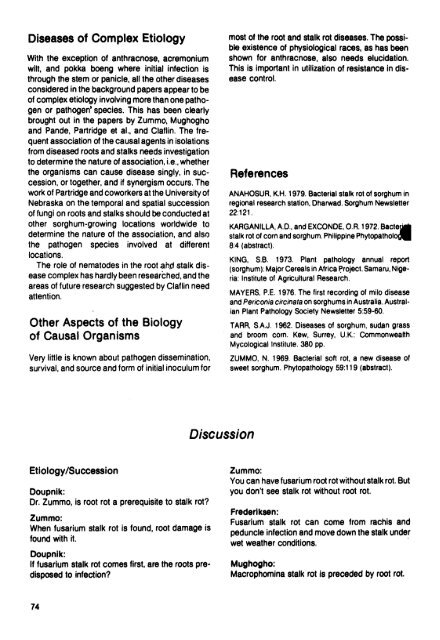Create successful ePaper yourself
Turn your PDF publications into a flip-book with our unique Google optimized e-Paper software.
Diseases of Complex Etiology<br />
With the exception of anthracnose, acremonium<br />
wilt, and pokka boeng where initial infection is<br />
through the stem or panicle, all the other diseases<br />
considered in the background papers appear to be<br />
of complex etiology involving more than one patho-<br />
gen or pathogen' species. This has been clearly<br />
brought out in the papers by Zummo, Mughogho<br />
and Pande, Partridge et al., and Claflin. The fre-<br />
quent association of the causal agents in isolations<br />
from diseased roots and stalks needs investigation<br />
to determine the nature of association, i.e., whether<br />
the organisms can cause disease singly, in suc-<br />
cession, or together, and if synergism occurs. The<br />
work of Partridge and coworkers at the University of<br />
Nebraska on the temporal and spatial succession<br />
of fungi on roots and stalks should be conducted at<br />
other sorghum-growing locations worldwide to<br />
determine the nature of the association, and also<br />
the pathogen species involved at different<br />
locations.<br />
The role of nematodes in the root ahd stalk dis-<br />
ease complex has hardly been researched, and the<br />
areas of future research suggested by Claflin need<br />
attention.<br />
Other Aspects of the Biology<br />
of Causal Organisms<br />
Very little is known about pathogen dissemination,<br />
survival, and source and form of initial inoculum for<br />
Doupnik:<br />
Dr. Zummo, is root rot a prerequisite to stalk rot?<br />
Zummo:<br />
When fusarium stalk rot is found, root damage is<br />
found with it.<br />
Doupnik:<br />
If fusarium stalk rot comes first, are the roots pre-<br />
disposed to infection?<br />
Discussion<br />
most of the root and stalk rot diseases. The possi-<br />
ble existence of physiological races, as has been<br />
shown for anthracnose, also needs elucidation.<br />
This is important in utilization of resistance in dis-<br />
ease control.<br />
References<br />
ANAHOSUR, K.H. 1979. Bacterial stalk rot of sorghum in<br />
regional research station, Dharwad. Sorghum Newsletter<br />
22:121.<br />
KARGANILLA, A.D., and EXCONDE, O.R. 1972. Bacte<br />
stalk rot of corn and sorghum. Philippine Phytopatholo<br />
8:4 (abstract).<br />
KING, S.B. 1973. Plant pathology annual report<br />
(sorghum): Major Cereals in Africa Project. Samaru, Nige-<br />
ria: Institute of Agricultural Research.<br />
MAYERS, P.E. 1976. The first recording of milo disease<br />
and Periconia circinata on sorghums in Australia. Austral-<br />
ian Plant Pathology Society Newsletter 559-60.<br />
TARR, S.A.J. 1962, Diseases of sorghum, Sudan grass<br />
and broom corn. Kew, Surrey, U.K.: Commonwealth<br />
Mycological Institute. 380 pp.<br />
ZUMMO, N. 1969. Bacterial soft rot, a new disease of<br />
sweet sorghum. Phytopathology 59:119 (abstract).<br />
Zummo:<br />
You can have fusarium root rot without stalk rot. But<br />
you don't see stalk rot without root rot.<br />
Frederi ksen:<br />
Fusarium stalk rot can come from rachis and<br />
peduncle infection and move down the stalk under<br />
wet weather conditions.<br />
Mughogho:<br />
Macrophomina stalk rot is preceded by root rot.
















